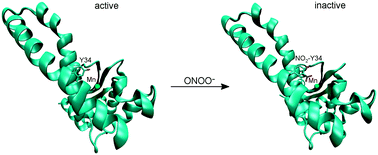Human Mn-superoxide dismutase inactivation by peroxynitrite: a paradigm of metal-catalyzed tyrosine nitration in vitro and in vivo
Abstract
Human MnSOD is a homotetramer and represents an essential mitochondrial antioxidant enzyme, which catalyzes the dismutation of superoxide radicals (O2˙−) at near diffusion-controlled rates. Under a variety of disease conditions and in the process of aging, nitric oxide (˙NO) can outcompete MnSOD and react with O2˙− to yield the potent oxidant peroxynitrite (ONOO−). Then, peroxynitrite can promote the regio-specific nitration of MnSOD at active site tyrosine 34, which turns the enzyme inactive. In this review we assess the kinetic aspects of the formation of peroxynitrite in the presence of MnSOD and the biochemical mechanisms of peroxynitrite-mediated MnSOD nitration. In particular, the central role of the Mn atom in the reaction of the enzyme with peroxynitrite (k = 1.0 × 105 M−1 s−1 per tetramer at pH = 7.4 and T = 37 °C) and the catalysis of nitration at the active site are disclosed. Then, we analyze at the atomic level of detail how a single oxidative post-translational modification in the enzyme, namely the nitration of tyrosine 34, results in enzyme inactivation. Herein, kinetic, molecular, structural biology and computational studies are integrated to rationalize the specificity and impact of peroxynitrite-dependent MnSOD tyrosine nitration in vitro and in vivo from both functional and structural perspectives.

- This article is part of the themed collections: Metallomics Recent HOT articles and Recent Review Articles


 Please wait while we load your content...
Please wait while we load your content...